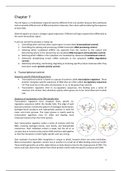Samenvatting
Summary Molecular cell biology (8RB00)
- Instelling
- Technische Universiteit Eindhoven (TUE)
Dit is een uitgebreide samenvatting van het boek Molecular Biology of the Cell (6th edition) door Alberts. In dit document is hoofdstuk 7, 8, 12, 13, 15, 17, 18, 20 en 24 uitgebreid uitgewerkt, waarbij de focus wel ligt op de dingen die verteld zijn tijdens de colleges van Moleculaire Celbiologie (...
[Meer zien]





